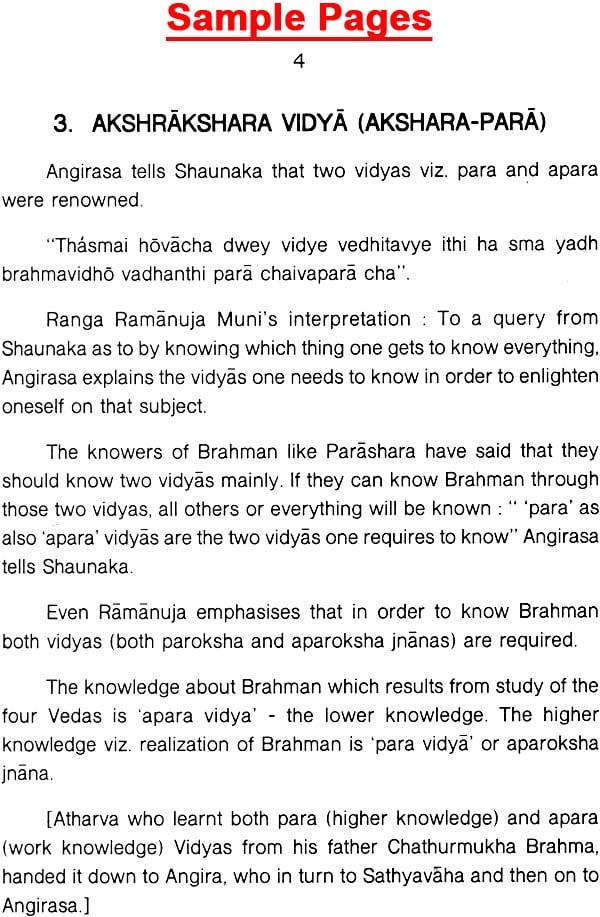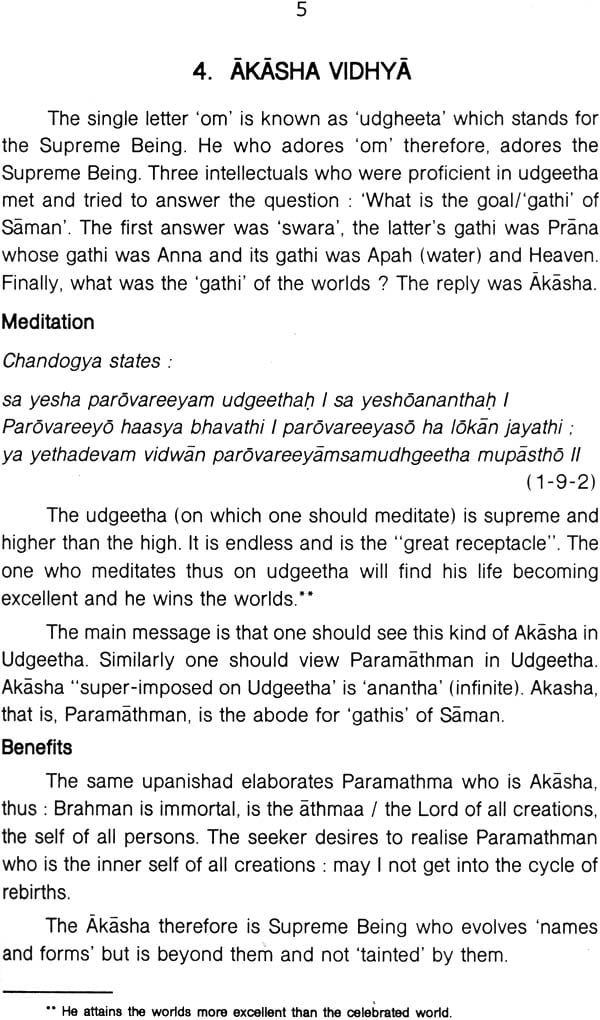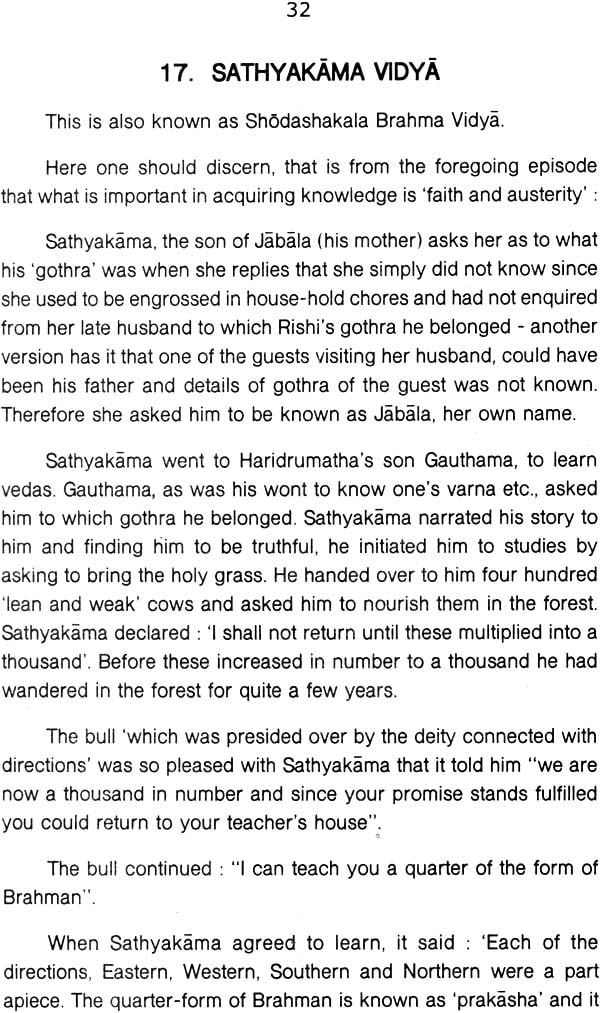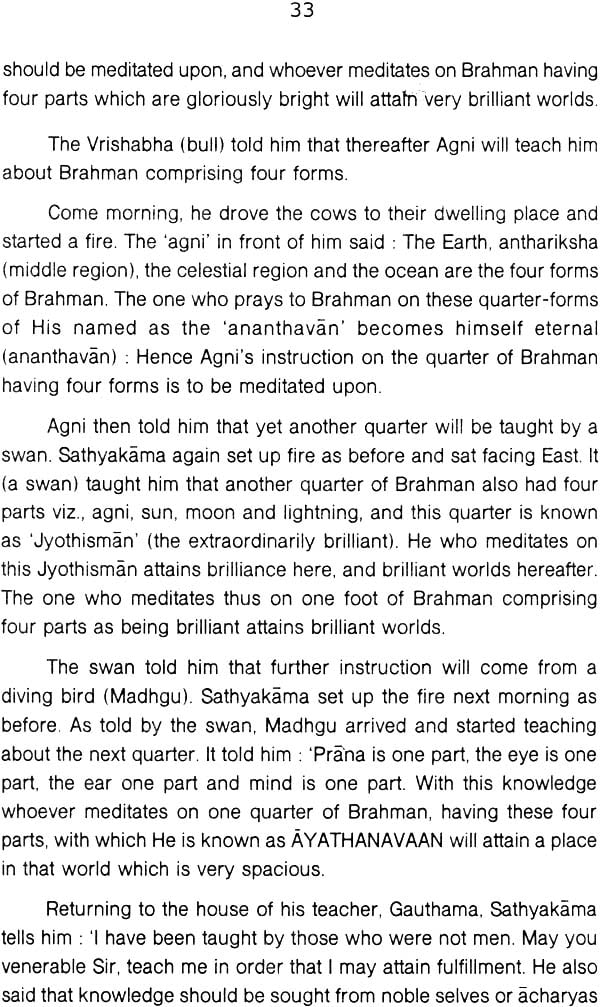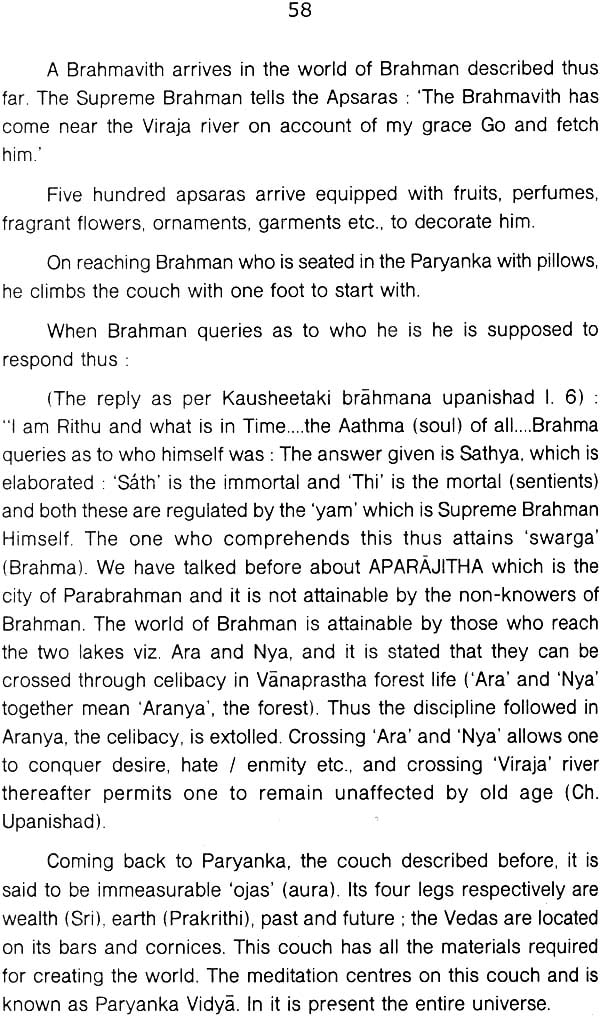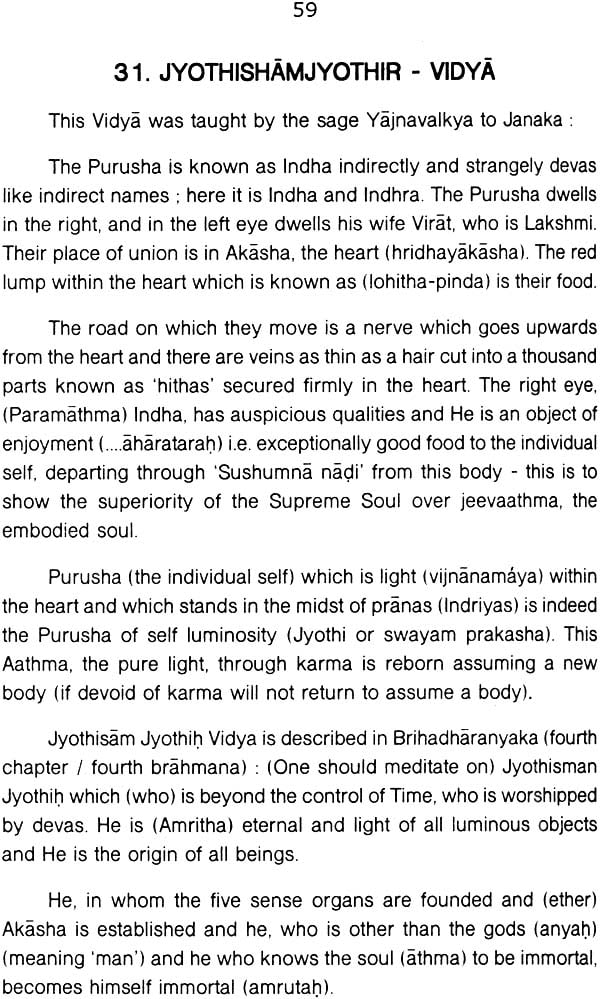
An Introduction to 32 Brahma Vidyas (Secret Doctrines)
Book Specification
| Item Code: | NAM952 |
| Author: | K. R. Krishnaswami |
| Publisher: | A & K PRAKASHANA |
| Language: | English |
| Edition: | 2011 |
| Pages: | 72 |
| Cover: | Paperback |
| Other Details | 8.5 inch X 5.5 inch |
| Weight | 100 gm |
Book Description
(By H. H. Sri Sri Rangapriya Mahaswamigal)
With the most sacred remembrance of the lustrous and lotus- like feet of the Supreme Lord Narayana and the worshipful feet of the revered Acharyas, we raise our hand in benediction over the author of this beautiful and enlightening book-let on the most sacred branch of learning called Brahma Vidya. Sri K.R. Krishnaswami who is endowed with sweetness and light which are the characteristic features of a cultured person is well known in the world of thoughtful readers by his works on the famous threefold authority (Prasthana thraya) of Vedanta, the devotional lyrics of Alwars and Acharyas, smrithi, purana, ithihasa and kavyas and the text of guidance for daily worship (Nithya grantha) and Agamas, a few of which have run into many editions. The work which is being presented herewith deals with Brahma Vidyaas or the spiritual modes of meditation and worship which when practised leads directly or indirectly to the Supreme Being.
The word vidya which is derived from the root vid (to know, to learn) meaning learning in general has fourteen divisions - the four vedas with their six auxiliaries, Mimamsa, Nyaya, Dharma Shasthra and Purana (Angani vedaschatvaro, mimaamsaa nyaaya vistarah, Dharma shaastram, puraanancha, vidyahyeta chaturdasha). But it is also proclaimed that only that learning which helps us to escape from metamorphosis and attain the feet of the Lord is really Vidyaa (Saa vidyaa vimukthaye). The lord in his divine song proclaims that adhyatma vidya surpasses all other vidyas ‘Adhyatma vidyaa vidyaanaam’. The famous trio of Vedanta namely the Upanishads, Brahma sutras and the Bhagavad Gita and especially first two of them refer to thirty two such Brahma Vidyas leading to the Supreme (though some of them promise worldly goods also). They take the forms of meditation and worship with utmost faith and fervour. The last one among them namely Nyaasa is proclaimed as the most excellent ‘Tasmaannyaasa mesham I Tapasaa mati rikta rnaahuh’.
This Nyasa (Supreme surrender) called by various names such as prapatti, Bharanyaasa, nikshepa and sharanagati is hailed in puranas, itihasas and agamas also as the most efficacious. It demands complete surrender to God with full faith and fervour and conviction in His saving power. It demands a life in full agreement to His commands keeping at a distance all that is disagreeable to Him and promises liberation to the practitioner at the end of his one lifetime itself. The greatness, glory and efficacy of this way is defended by Acharya Vedanta Desika in his Nikshepa Rakshaa with ail the fire and strength of his soul.
The author of this book gives an account of all the aforesaid thirty two vidyas in an easily understandable language based on authentic works of the three prasthaanas, the commentaries and original works of the revered acharyas on them. May his valuable work reach the hands of a large number of readers and enlighten them.
We have heard of terms like dhyana, upasana and meditation. One requires to clarify the meanings before embarking on understanding of Vidyas. Dhyana means meditation, while upasana is used to signify a long and continued meditation. ‘Upasanas’ also stand for ‘Brahmavidyas’. As Ramanuja says upanishad itself describes (for e.g.) Madhu vidya as Brahma vidya. Vidyas are the practical side of the teachings of upanishads vidyas are not to be taken as conveying just knowledge, they being also exercises in meditation.
Vedantha Suthras deal with vidyas. Upasana here is defined as ‘enquiry into Brahman, that is, study, investigation and reasoning, contemplation and ‘meditation’.
It is said that the Lord cannot be realised by means of studying limited portions of scripture, meaning that the Supreme Lord is to be enquired into by a study of all the Vedas (that is, the true meaning of all the Vedas supplemented by a study of lthihasas, Puranas etc.) the question that arises here is as to whether it is possible by all persons? In Bhavishya purana it is said that: “by Brahma, the four- faced, the Supreme Lord is to be meditated upon with complete comprehension of all His qualities; by gods, only to the appropriate extent, according to their capability; but by men (human beings), only with the comprehension of a few qualities”. “For the sake of meditation all the qualities are declared by the scriptures”.
Upasana or continued meditation on Lord’s qualities like His being ‘Sathyam, Jnanam, Anantham’ leads to God-realisation. The upasana’s nature is best described by the statement: “thailadharavath avicchinna smrithi santhathi roopa” - like ‘constant flow of oil through a wick’.
CANDIDATE FOR UPASANA
A person who is knowledgeable enough to realise that he should act in this life to put an end to the cycle of births and deaths, becomes deserving of experiencing the ecstacy of the Lord - it is such a person’s sheer love towards the Lord that impels him towards constant meditation.
One might ask: if one gets absorbed in such meditation, it might affect or obviate his daily karmic duties and obligations as envisaged in the Gita. The answer is a clear ‘no’ and it is enjoined on everyone to discharge his duties as per his varna. The duties themselves are to be carried out in a spirit of worship to the Lord.
INTO THE VlDYA PROPER
Details on the various Brahma vidyas are known as ‘guhya adesha’ or secret teaching in upanishads. In each vidya one discerns a particular attribute or aspect of the Supreme soul.
The source books for vidyas are mainly the three Upanishads Chandogya, Brihadaranyaka and Taitthireeya. Vedantha Suthras (Chapter III, Padha III) contain details of the vidyas.
There are on the whole 32 vidyas - there could be one or two more vidyas: there is a slight difference between two acharyas in the number: Ramanuja names 32 and Shankara 30. For our purpose we take the larger number.
| Foreword | iii | Contents | v | Introduction | vi | The VIDYAS | 1 | Gayathri Vidya | 1 | 2 | Aksi Vidya | 3 | 3 | Akshrakshara Vidya (Akshara-Pa | 4 | 4 | Akasha Vidhya | 5 | 5 | Sadh-Vidya | 6 | 6 | Antharadithya Vidya | 7 | 7 | Bhooma Vidya | 9 | 8 | Madhu Vidya | 12 | 9 | Purusha Vidya | 15 | 10 | Udgeetha Vidya | 17 | 11 | Vysvanara Vidya | 18 | 12 | Panchagni Vidya | 22 | 13 | Dahara Vidya | 25 | 14 | Prana and Prathardhana Vidyas | 27 | 15 | Nachikethaqni - Vidya | 29 | 16 | Upakosala - Vidya | 30 | 17 | SathyakaMa Vidya | 32 | 18 | Pranagnihothra Vidya | 35 | 19 | SAmvarga Vidya | 37 | 20 | Gargi-Akshara Vidya | 39 | 21 | Bhrugu - Varuni Vidya | 41 | 22 | Anandhamaya - Vidya | 42 | 23 | Angushtamathra - Vidya | 43 | 24 | Shandilya - Vidya | 45 | 25 | Balaki - Vidya | 47 | 26 | Ushastha-Kahola - Vidya | 49 | 27 | Uddhalaka-aruni - Vidya | 51 | 28 | Maithreyee - Vidya | 53 | 29 | Pararna-Purusha-Vldya | 55 | 30 | Paryanka - Vidya | 57 | 31 | Jyothishamjyothir - Vidya | 59 | 32 | Sriman- Nyasa- Vidya | 62 |
